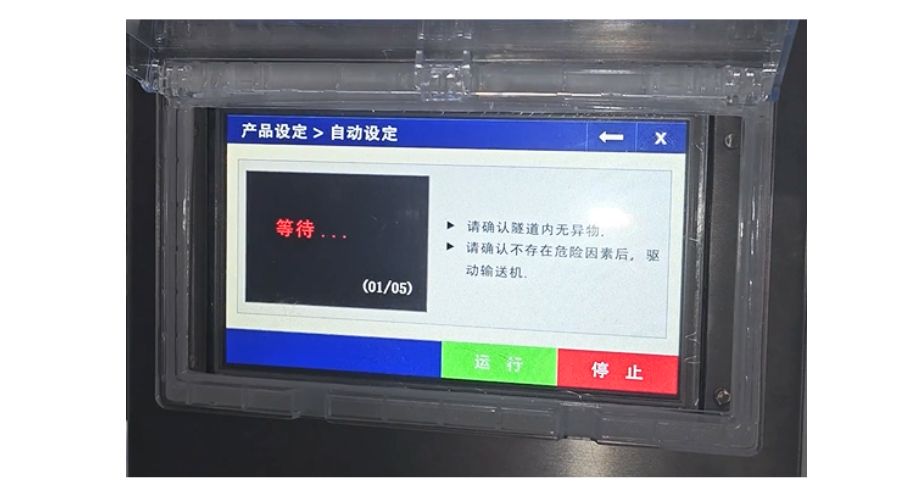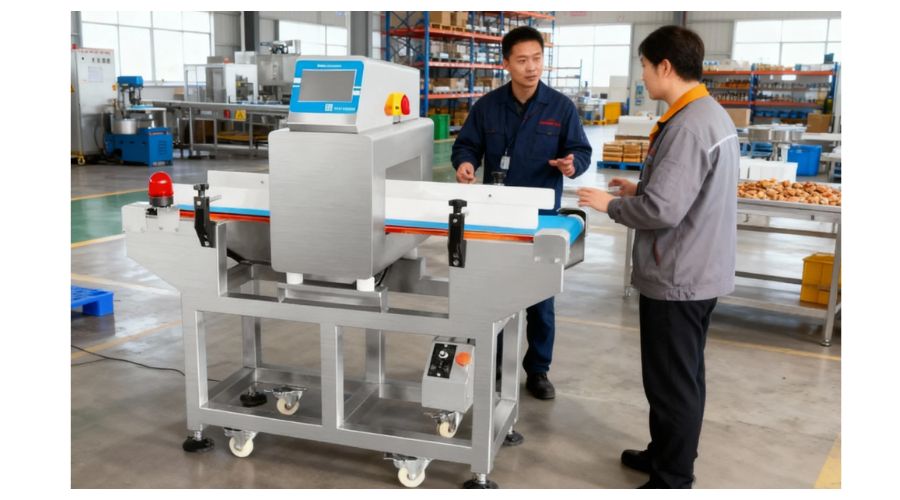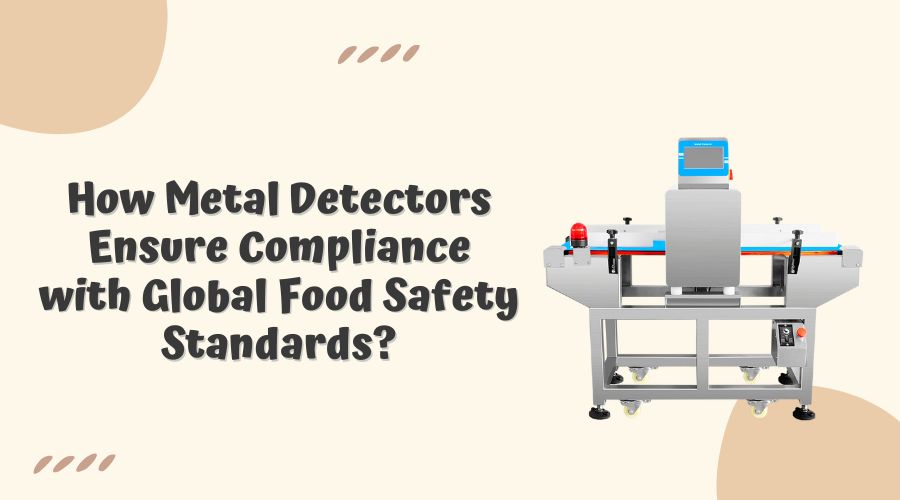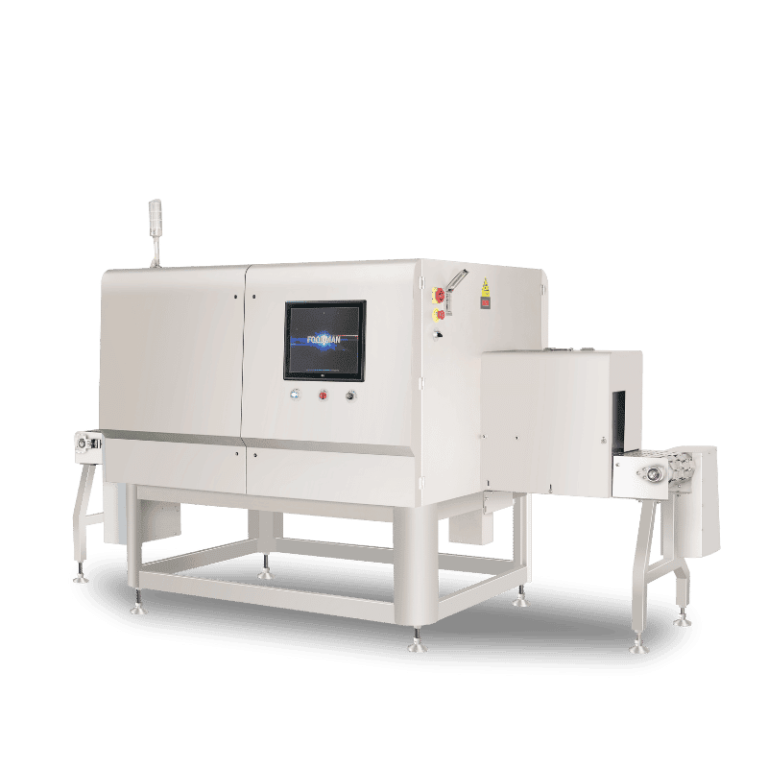Introduction: The Compliance Imperative
Why Global Food Trade Demands Stricter Food Safety Oversight
In today’s interconnected world, food products often cross multiple borders before reaching consumers. This globalization exposes production lines to increased contamination risks, making food safety a non-negotiable priority. Companies exporting to international markets must adhere to stringent standards, ensuring every product is free from contaminants. In this context, metal detector in food industry solutions play a pivotal role in preventing foreign objects from entering the supply chain.
Increasing Scrutiny from Regulators, Retailers, And Consumers
Regulatory authorities, major retailers, and informed consumers are increasingly demanding transparency and accountability. Non-compliance can lead to product recalls, financial penalties, and reputational damage. By implementing robust detection systems, such as food industry metal detectors and metal detector for food production line solutions, manufacturers can demonstrate proactive adherence to global food safety regulations. These systems not only detect physical hazards but also provide documented proof of due diligence during audits and inspections.
Positioning Metal Detector in Food Industry as a Frontline Compliance Measure
Understanding how a metal detector works is essential for companies seeking to reinforce compliance. Modern metal detectors in food industry use advanced electromagnetic technology to identify ferrous, non-ferrous, and stainless steel fragments. Knowing what do metal detectors detect and what can a metal detector detect allows manufacturers to configure their systems accurately for different product types and packaging formats. By integrating how does a metal detector work into production lines, operators can ensure continuous monitoring, effectively making these devices a frontline defense against contamination while strengthening regulatory compliance.
Global Food Safety Challenges and Risks
Common Sources of Contamination in Modern Food Production
Modern food production lines involve complex machinery, high-speed conveyors, and multiple handling points, all of which can introduce physical contaminants. Metals from worn equipment, fragments from packaging materials, and foreign objects during ingredient handling are frequent sources of risk. Understanding how a metal detector works and integrating metal detector in food industry systems helps manufacturers identify and remove contaminants before products leave the line. Knowledge of what do metal detectors detect and what can a metal detector detect allows precise configuration for different product types, ensuring robust food safety throughout the production process.
Impact of Globalization: Extended Supply Chains, Complex Ingredients
Globalized food supply chains introduce new challenges. Ingredients may come from multiple countries, each with different handling standards. Complex recipes increase the likelihood of contamination due to the diversity of raw materials. Installing food industry metal detectors and understanding how does a metal detector work in these scenarios ensures that potential metallic contaminants are caught early, even when products and ingredients vary in density, moisture, or packaging. By leveraging metal detector for food production line solutions, manufacturers can maintain consistent quality across global operations.
Financial, Legal, And Reputational Risks of Non-compliance
Failing to meet global food safety standards can have severe consequences. Contaminated products may trigger costly recalls, legal liabilities, and long-term brand damage. Properly configured metal detectors in food industry minimize these risks by providing accurate detection of ferrous, non-ferrous, and stainless steel fragments. Knowing how the metal detector works ensures operators can monitor high-risk points and maintain compliance with regulatory requirements, ultimately protecting both consumers and the company’s financial and reputational standing.
Beyond Detection: The Compliance Role of Metal Detectors
Not Just “what Do Metal Detectors Detect” but How They Help Companies Prove Due Diligence
While understanding what do metal detectors detect and what can a metal detector detect is essential, the true value of metal detector in food industry goes beyond simple detection. Properly implemented food industry metal detectors demonstrate a company’s commitment to food safety and due diligence. Knowing how a metal detector works enables manufacturers to strategically place detectors at critical points on the line, ensuring contaminants are caught and compliance obligations are met. By actively monitoring and documenting detection processes, companies can prove that they have taken reasonable steps to prevent contamination.

Documented Inspection Records for Audits and Certifications
Modern metal detector for food production line systems automatically log inspection data, creating comprehensive audit trails. These records are critical during regulatory inspections or when obtaining certifications such as HACCP, BRC, or FDA compliance. Understanding how the metal detector works ensures accurate recording of every detection event. By integrating how does a metal detector work knowledge into operational protocols, manufacturers maintain traceable and verifiable evidence of proactive food safety management.
Supporting Traceability and Accountability Across Production Lines
Beyond individual inspection points, metal detectors in food industry support traceability throughout the entire production process. Operators can track exactly when and where a contaminant was detected, linking results to specific batches, shifts, or equipment. Understanding how a metal detector works and applying how the metal detector works in conjunction with line monitoring systems enhances accountability. This capability ensures that companies can respond quickly to potential issues, minimize risk, and demonstrate full control over their food production line safety practices.
Sector-Specific Compliance Applications
Metal Detector for Food Production Line in Meat & Poultry: Preventing Recalls
In meat and poultry processing, food safety risks are particularly high due to bone fragments, metal shavings from equipment, or other foreign objects. Understanding how a metal detector works allows operators to catch even small contaminants before products reach consumers. Implementing metal detector for food production line systems ensures that what do metal detectors detect and what can a metal detector detect aligns with strict regulatory and retailer standards. Effective use of food industry metal detectors minimizes the risk of recalls, protecting both the brand reputation and consumer health.

Confectionery & Bakery: Small Contaminants, High Audit Requirements
Confectionery and bakery products, with their small size and complex ingredients, pose unique challenges for contamination detection. Knowing how does a metal detector work helps production managers adjust sensitivity for sugar-coated candies, chocolate, and baked goods. Using metal detector in food industry setups tailored for these products ensures detection of ferrous, non-ferrous, and stainless steel fragments, fulfilling stringent audit and certification requirements. The ability to demonstrate how the metal detector works during inspections reinforces compliance and boosts consumer confidence.
Rozen/Ready Meals: Demonstrating Adherence to HACCP and Retailer Codes
Frozen and ready-to-eat meals require careful monitoring because packaging materials and frozen textures can create “product effect” challenges. Understanding how a metal detector works allows operators to compensate for these effects and maintain detection accuracy. Deploying metal detector for food production line solutions in these environments ensures that what can a metal detector detect covers all likely contaminants, supporting compliance with HACCP standards and retailer codes. By integrating food industry metal detectors into frozen meal lines, manufacturers can provide documented evidence of due diligence and safety commitment.
Bridging Compliance with Technology
Integration with IoT for Automated Reporting and Audit Readiness
Modern food industry metal detectors can be connected to IoT platforms, allowing for automated data collection and reporting. By understanding how the metal detector works, operators can ensure that every detection event is logged accurately. This capability helps manufacturers demonstrate food safety compliance during audits and inspections, providing real-time visibility into production lines. Leveraging IoT connectivity ensures that metal detector in food industry applications are not only detecting contaminants but also maintaining detailed records for regulatory accountability.
Linking Detection Data with ERP/QMS Systems
Integrating metal detection data with Enterprise Resource Planning (ERP) or Quality Management Systems (QMS) enables centralized monitoring of production quality. Knowing how does a metal detector work allows quality teams to interpret detection results effectively and ensure that what do metal detectors detect and what can a metal detector detect is recorded and analyzed consistently. This seamless connection between detection equipment and management systems enhances traceability, facilitates faster decision-making, and strengthens overall compliance in the food industry metal detectors context.
Ai-Driven Systems Learning from How the Metal Detector Works to Reduce False Rejects
Advanced metal detector for food production line solutions now incorporate AI algorithms that learn from operational data. Understanding how a metal detector works enables these systems to adapt sensitivity settings dynamically, reducing false rejects caused by product effects such as moisture, seasoning, or packaging variations. By leveraging how the metal detector works in combination with AI, manufacturers can maintain high throughput while ensuring food safety, minimizing waste, and meeting stringent regulatory standards.
The Human Factor in Compliance
Training Operators on How a Metal Detector Works to Avoid Misuse
Even the most advanced metal detector for food production line is only as effective as the operators who use it. Comprehensive training on how a metal detector works ensures staff can correctly identify contaminants and understand what do metal detectors detect in various product types. Educating operators on what can a metal detector detect prevents misuse, reduces false alarms, and maintains food safety across the production line. Properly trained personnel help maximize the efficiency and accuracy of food industry metal detectors.

Building a Culture of Food Safety Beyond Just Equipment
Compliance with global standards goes beyond having metal detector in food industry systems in place. Organizations must foster a proactive food safety culture where employees understand the critical role of inspection technology. By reinforcing the importance of how the metal detector works, teams remain vigilant in identifying potential hazards, maintaining hygiene standards, and supporting continuous improvement. This human factor complements the technology, ensuring that food safety is embedded in every stage of production.
Regular Verification and Validation as Part of Global Certification Requirements
Global certifications such as HACCP, BRC, and ISO require ongoing verification and validation of detection equipment. Understanding how does a metal detector work allows quality assurance teams to perform accurate calibration checks and verify that what do metal detectors detect and what can a metal detector detect aligns with standards. Regular testing of metal detector for food production line systems ensures consistent performance, strengthens audit readiness, and maintains compliance with international food industry metal detectors requirements.
Regional Enforcement and Case Studies
Case Where Failure to Use Food Industry Metal Detectors LED to Recalls
There have been multiple incidents in which the absence or improper use of a metal detector for food production line caused contaminated products to reach consumers, resulting in costly recalls. Understanding how a metal detector works and knowing what do metal detectors detect could have prevented these situations. Such cases highlight the importance of food industry metal detectors in maintaining food safety and protecting both consumer trust and brand reputation.
Examples of Successful Compliance Audits Backed by Detection Technology
Companies that integrate metal detector in food industry systems effectively often demonstrate excellent results during compliance audits. By maintaining thorough records of how the metal detector works, including sensitivity settings and detection logs, manufacturers can show auditors precisely what can a metal detector detect in their products. These documented practices have helped businesses pass rigorous inspections, proving their commitment to food safety and operational excellence.
Different Enforcement Levels: North America, EU, Asia-Pacific
Regulatory enforcement and expectations vary across regions. In North America, agencies such as the FDA prioritize stringent contamination control and expect detailed documentation of how does a metal detector work in the production line. The EU emphasizes both consumer protection and traceability, requiring that food industry metal detectors clearly show what do metal detectors detect in high-risk products. Meanwhile, in Asia-Pacific, emerging markets are adopting stricter standards, making the adoption of metal detector for food production line systems essential to comply with evolving regulations. Awareness of how a metal detector works in these diverse regulatory contexts helps manufacturers maintain food safety across global supply chains.
Preparing for the Future of Compliance
Moving from Reactive to Predictive Food Safety
The future of food safety lies in predictive strategies rather than reactive responses. By understanding how a metal detector works and analyzing detection data over time, manufacturers can anticipate contamination risks before they occur. Food industry metal detectors now offer features that allow operators to track patterns and trends, enabling proactive decision-making. This predictive approach reduces recalls, improves operational reliability, and strengthens overall compliance performance.
Role of Hybrid Inspection (Metal + X-Ray + Vision) in Next-Gen Compliance
Next-generation inspection systems combine metal detectors in food industry lines with X-ray and vision technologies, creating a multi-layered approach to contamination prevention. Knowing what do metal detectors detect versus what X-ray or vision systems identify allows manufacturers to cover a wider range of potential hazards. By understanding how the metal detector works in conjunction with other inspection tools, companies can ensure comprehensive product safety and meet increasingly stringent global regulations.
How Snack and Packaged Food Producers Can Future-Proof Against Evolving Standards
Snack and packaged food producers must adopt flexible systems to stay ahead of changing regulations. Implementing metal detector for food production line systems with adaptive sensitivity ensures that even new packaging materials or ingredients can be inspected accurately. Awareness of what can a metal detector detect and continuous operator training on how a metal detector works help producers maintain food safety while reducing operational disruptions. Integrating these technologies with real-time monitoring and data analytics positions companies to meet evolving standards and maintain global market access.
Conclusion
Metal Detectors as Both Compliance Enablers and Brand Protectors
Metal detectors in food industry serve a dual purpose: ensuring food safety and safeguarding brand reputation. Understanding how a metal detector works allows manufacturers to detect even the smallest ferrous, non-ferrous, or stainless steel fragments. Knowing what do metal detectors detect and what can a metal detector detect enables proactive monitoring that prevents contamination incidents, costly recalls, and potential legal repercussions, making these systems essential compliance enablers.
Key to Harmonizing Global Food Safety with Efficient Operations
Deploying food industry metal detectors correctly helps companies balance regulatory compliance with operational efficiency. When operators understand how the metal detector works, they can strategically place devices in critical control points and integrate them with automated rejection and monitoring systems. This ensures comprehensive food safety coverage without slowing production, effectively harmonizing safety standards with high-speed operations on a metal detector for food production line.
Call to Action: Treat Metal Detection Not as Optional, But as a Compliance Cornerstone
In an era of stringent global standards and rising consumer expectations, metal detection should be viewed as a non-negotiable component of food safety strategy. Manufacturers must train staff on how does a metal detector work, maintain regular system validation, and stay updated on technological advancements. Recognizing how the metal detector works and leveraging its full capabilities allows companies to future-proof their operations, ensuring compliance, protecting their brand, and maintaining trust in the marketplace.
FAQ
Q: How does a metal detector work in the food industry?
A: A metal detector generates an electromagnetic field to identify metallic disturbances as food passes through, detecting ferrous, non-ferrous, and stainless steel contaminants.
Q: What do metal detectors detect in food production lines?
A: They detect fragments of metals such as iron, aluminum, or stainless steel introduced during processing, packaging, or ingredient handling.
Q: What can a metal detector detect that other inspection systems might miss?
A: Metal detectors excel at identifying very small metallic fragments in high-speed production lines where physical contaminants pose high risks.


